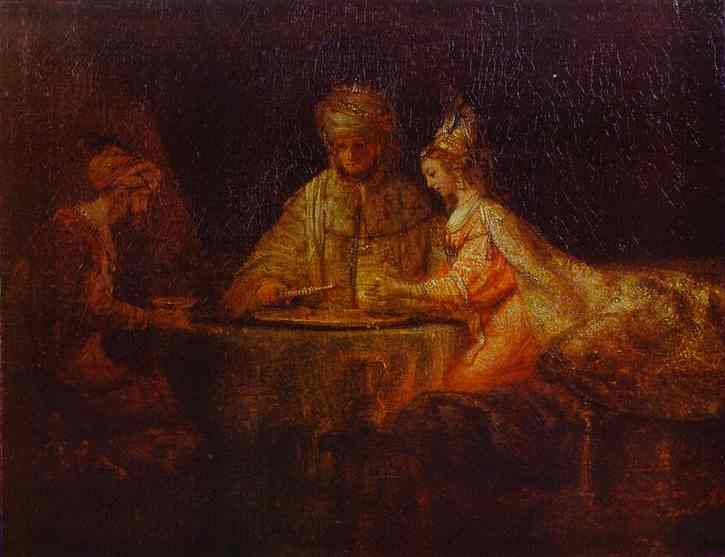Beschreibung
Rembrandt's "Ahasuerus (Xerxes) - Haman and Esther", created in 1660, is a rich depiction of a biblical episode that reflects both the artist's technical mastery and the complex emotional tensions that define his late works. In this painting, Rembrandt captures the tense moment when King Ahasuerus (or Xerxes) is confronting Haman, the scheming prime minister, in the presence of Esther, his Jewish wife. This dramatic triangle is a faithful reflection of Rembrandt's signature narrative style, where every figure and every gesture tells a story beyond the visible.
The composition of the work is notable for its balance and dynamism. The arrangement of the characters creates a clear visual hierarchy. Esther, positioned in the foreground, occupies a position of vulnerability and dignity. Her gaze, both imploring and defiant, connects emotionally with the viewer, while Ahasuerus is presented in a higher plane, dominating the scene with his power and uncertainty. Haman, in the background, is enveloped in an atmosphere of despair and panic, evidenced by his tense posture and the falling of his cloak, symbolizing his fall from grace. The diagonal formed by the bodies and clothes of the characters adds a tension that resonates with the intrigue of the narrative.
The rich, deep colours Rembrandt uses bring profound layers of meaning to the work. The dark shades of gold and red that predominate in the characters’ clothing contribute to the visual richness of the painting, evoking the opulence of the royal palace. However, these colours are also charged with symbolism, representing Haman’s fleeting fortune in the face of impending doom. The choice of colour and light are defining characteristics of Rembrandt’s style, and here they manifest themselves in a way that reinforces the emotion latent in the scene. The light shining on the figures, especially the faces, acts as a beacon, illuminating not only the form, but also the inner conflict of each character.
One of the most intriguing features of this painting is its relationship to contemporary works by Rembrandt and other 17th-century artists. By the mid-17th century, Baroque painting in Northern Europe had begun to explore the emotionality and psychology of its subjects in a more exclusive way. Rembrandt is undoubtedly a pioneer in this exploration, distancing himself from the more formal and dramatic representations typical of his time. His personal search for an intimate and emotional narrative is revealed through the expression of the faces and hands, in the gestures so subtle but loaded with meaning.
The theme of history, power and betrayal is especially relevant in a time when political and social changes were taking place throughout Europe. Through a narrative that explores personal conflicts within a framework of political tension, Rembrandt invites the viewer to a deeper reflection on the implications of human actions and destiny.
"Ahasuerus (Xerxes) - Haman and Esther" is a work that showcases Rembrandt's technical mastery and his ability to capture the complexity of human emotions through light, color and form. It is a testament to his ability to not only tell a story, but to infuse it with the weight of the human condition, creating an everlasting bond between his art and those who view it. When looking at this work, we not only see its characters but also feel the story it unfolds, resonating through the centuries.
KUADROS ©, a famous painting on your wall.
Hand-made oil painting reproductions, with the quality of professional artists and the distinctive seal of KUADROS ©.
Painting reproduction service with satisfaction guarantee. If you are not completely satisfied with the replica of your painting, we will refund 100% of your money.

